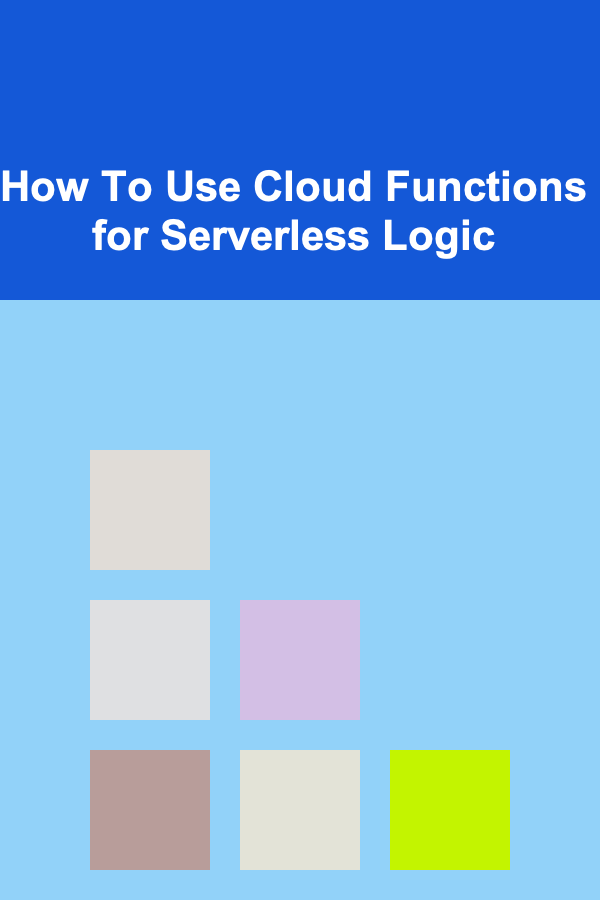
How To Use Cloud Functions for Serverless Logic
ebook include PDF & Audio bundle (Micro Guide)
$12.99$11.99
Limited Time Offer! Order within the next:

The concept of serverless computing has revolutionized how developers build and deploy applications. With cloud computing offering infrastructure as a service, serverless platforms have emerged to simplify backend processes, offering more efficient, scalable, and cost-effective solutions. One of the most powerful tools in serverless computing is Cloud Functions , which allows you to run your application logic without worrying about managing servers or infrastructure. This article will delve deep into how to use Cloud Functions for serverless logic, explaining its core concepts, benefits, best practices, and how it integrates into modern development workflows.
What Are Cloud Functions?
Cloud Functions are event-driven, serverless compute services that allow you to execute code in response to events triggered by other services, without managing the underlying infrastructure. Unlike traditional server setups, where developers manage servers, storage, and networking, cloud functions focus solely on the execution of code.
Cloud Functions are typically hosted by cloud providers like Google Cloud (Google Cloud Functions), Amazon Web Services (AWS Lambda), and Microsoft Azure (Azure Functions). They are a key element of serverless architecture, enabling developers to write logic that automatically scales based on demand without requiring them to worry about provisioning or maintaining servers.
Core Concepts of Cloud Functions
Before diving into how Cloud Functions can be used for serverless logic, it's essential to understand a few key concepts.
1. Event-Driven Architecture
Cloud Functions operate on an event-driven model, meaning they execute code in response to specific triggers, such as HTTP requests, database changes, file uploads, or messaging events.
- Example: A Cloud Function might be triggered when a new user signs up in a database or when an image is uploaded to cloud storage. The event could be anything that the cloud provider can detect.
2. Statelessness
Each execution of a cloud function is independent, meaning it does not retain any memory of previous executions. This stateless nature simplifies the execution model, ensuring that developers do not need to manage session data across requests.
- Example: If a user uploads a file, the Cloud Function will process the file during that request and complete the job, without storing any information about the previous or future executions.
3. Scaling on Demand
Cloud Functions automatically scale based on the volume of incoming requests or events. If many users trigger the function simultaneously, the cloud provider will scale the function's execution to handle the load. This elasticity ensures that the system remains performant and cost-effective.
- Example: If your function needs to handle 10 requests per second, it will scale up. If the requests decrease, it will scale down, so you only pay for what you use.
4. Short Execution Time
Cloud Functions are designed for short-lived tasks. They are typically limited to a few minutes of execution time (depending on the provider) to ensure that they remain lightweight and cost-efficient. For long-running tasks, developers may need to combine Cloud Functions with other services, such as managed container platforms or message queues.
- Example: A Cloud Function might be used to process a user's form submission or resize an image after it has been uploaded, with both tasks being completed in a short time span.
5. Pay-as-You-Go Pricing Model
One of the main advantages of Cloud Functions is the cost model. Since they are serverless, you're only charged for the time your function is actually running. This model removes the need to pay for idle server time, making it a highly cost-effective option for sporadic or unpredictable workloads.
- Example: If your function only runs for a few seconds once every few hours, you're only charged for those few seconds of execution.
Benefits of Using Cloud Functions for Serverless Logic
Using Cloud Functions for serverless logic offers several key benefits:
1. Simplified Development and Deployment
Cloud Functions simplify the development process by abstracting away the need to configure and maintain infrastructure. You only need to write the code for the function itself, and the cloud provider handles all the operational details such as scaling, load balancing, and resource management.
2. Cost Efficiency
Since Cloud Functions scale automatically and you only pay for execution time, you save money on unused resources. You don't need to provision servers or worry about server maintenance, and the pay-as-you-go model makes it easier to handle fluctuating workloads.
3. High Scalability
Cloud Functions are designed to automatically scale based on demand. When the function is invoked, it can spawn additional instances to handle more concurrent executions, ensuring that it remains performant even under heavy loads.
4. No Server Management
With Cloud Functions, there is no need to worry about setting up, maintaining, or securing servers. The cloud provider takes care of the underlying infrastructure, allowing developers to focus solely on writing and deploying the function code.
5. Seamless Integration with Cloud Services
Cloud Functions are tightly integrated with other cloud services, making it easy to connect to databases, object storage, messaging services, and more. This integration simplifies the architecture, reducing the need for complex configurations or third-party libraries.
How to Use Cloud Functions for Serverless Logic
Let's explore how you can implement serverless logic using Cloud Functions step by step. We will look at the basic components of a Cloud Function and go over practical use cases.
1. Choose Your Cloud Provider
Before writing any code, you'll need to select a cloud provider that offers serverless compute services. The three major providers offering Cloud Functions are:
- Google Cloud Functions: A fully managed serverless execution environment for building and connecting cloud services.
- AWS Lambda: Amazon's serverless compute service that executes code in response to events from AWS services or external triggers.
- Azure Functions: Microsoft's serverless compute offering that supports a wide range of programming languages and triggers.
2. Set Up Your Development Environment
Depending on the cloud provider you choose, the setup process will differ slightly. Here's a general process:
- Google Cloud Functions: Use Google Cloud Console or Cloud SDK (gcloud CLI) to deploy your function.
- AWS Lambda: Use AWS Management Console, AWS CLI, or AWS SDKs to create and deploy functions.
- Azure Functions: Use Azure Portal or Azure CLI to manage and deploy functions.
For local development, many cloud providers offer CLI tools that let you test and simulate function execution on your machine before deploying it to the cloud.
3. Write Your Cloud Function
Cloud Functions can be written in various programming languages, such as JavaScript (Node.js), Python, Go, or Java. The function must have a handler, which is the main entry point when the function is triggered.
- Example in Node.js (AWS Lambda):
const response = {
statusCode: 200,
body: JSON.stringify('Hello, World!'),
};
return response;
};
In this example, the function is triggered by an event (such as an HTTP request) and returns a simple "Hello, World!" message.
4. Define Event Triggers
A key aspect of Cloud Functions is defining event triggers, which are the events that cause the function to execute. Cloud providers support a variety of triggers, including:
- HTTP triggers: Used to create APIs or webhooks.
- Database triggers: Respond to changes in databases (e.g., Firebase, AWS DynamoDB).
- File triggers: Trigger functions when files are uploaded to cloud storage (e.g., Google Cloud Storage, AWS S3).
- Pub/Sub triggers: Activate functions in response to messages from message queues or topics (e.g., Google Pub/Sub, AWS SNS).
For example, an AWS Lambda function might be triggered when an object is uploaded to an S3 bucket:
const s3 = new AWS.S3();
const bucket = event.Records[0].s3.bucket.name;
const key = event.Records[0].s3.object.key;
const params = { Bucket: bucket, Key: key };
const file = await s3.getObject(params).promise();
console.log('File uploaded:', file);
return { statusCode: 200, body: 'File processed successfully.' };
};
This function will be invoked every time a new file is uploaded to the specified S3 bucket.
5. Deploy Your Cloud Function
Once your function is written and ready, it's time to deploy it to the cloud provider. You can deploy via the web console, command-line tools, or SDKs, depending on the cloud platform.
6. Monitor and Manage Your Cloud Function
Once your Cloud Function is deployed, it's important to monitor its execution. Most cloud providers offer logging and monitoring services to track function performance, errors, and invocations. For example:
- Google Cloud Functions integrates with Google Cloud Logging to monitor function executions.
- AWS Lambda integrates with Amazon CloudWatch to track logs and metrics.
- Azure Functions uses Azure Monitor for logging and diagnostics.
7. Combine Cloud Functions with Other Services
A key advantage of Cloud Functions is their ability to integrate with a wide range of other cloud services. You can use Cloud Functions as part of a larger serverless architecture by connecting them to databases, storage services, message queues, and more.
For example, you might use Cloud Functions to process data from an event stream, then store the results in a database or trigger further actions in other services.
Best Practices for Using Cloud Functions
1. Optimize Function Performance
Minimize cold starts (the latency that occurs when a Cloud Function is invoked after being idle for a while) by keeping function execution as lightweight as possible. Also, be mindful of the execution time and memory usage to reduce costs.
2. Secure Your Functions
Cloud functions should be secure by design. Use IAM (Identity and Access Management) roles to control access to cloud resources and ensure that your function only has permissions it needs.
3. Error Handling
Ensure robust error handling and logging to help troubleshoot any issues. Many cloud providers offer built-in monitoring and alerting tools that can help you track failures and manage retries.
4. Keep Functions Simple
Since Cloud Functions are best suited for small, discrete tasks, try to keep them focused on one purpose. Large, monolithic functions can reduce the benefits of serverless computing.
Conclusion
Cloud Functions offer a powerful way to run serverless logic, providing a scalable, cost-effective solution for modern application development. By leveraging event-driven architecture, automatic scaling, and integration with cloud services, you can build highly performant, secure, and flexible systems without worrying about managing infrastructure. Whether you're building a simple API, processing images, or responding to database changes, Cloud Functions allow you to focus solely on writing code that adds value to your application. As serverless computing continues to evolve, the role of Cloud Functions in simplifying application development will only grow.
Reading More From Our Other Websites
- [Whitewater Rafting Tip 101] From Calm Waters to White-Water Thrills: Choosing the Right Rafting Experience for Your Skill Level
- [Home Lighting 101] How to Design Elegant Outdoor Lighting for Your Deck or Patio
- [Personal Care Tips 101] How to Use Hair Mousse to Keep Your Hairstyle in Place All Day
- [Personal Care Tips 101] How to Select a Hair Mousse for Color-Treated Hair
- [Skydiving Tip 101] Top Tips for Crushing Your First Skydiving Lesson (And Staying Safe)
- [Organization Tip 101] How to Sort and Store Holiday Decorations Efficiently
- [Home Cleaning 101] How to Tackle Spring Cleaning Without Feeling Overwhelmed
- [Organization Tip 101] How to Set Up a System for Managing Your Email Inbox
- [Trail Running Tip 101] Trail vs. Road: Key Features That Set Trail Running Shoes Apart
- [Home Lighting 101] How to Select the Perfect Pendant Light for Your Dining Room

How to Organize DIY Pet Projects and Supplies
Read More
How to Save Space in Your Kids' Room with Creative Solutions
Read More
How to Set Up an Effective Property Inspection Schedule
Read More
How to Use Clear Containers for Easy Holiday Organization
Read More
How to Write Compelling Stories Behind Each Antique
Read More
10 Tips for Creating a To-Do List That Actually Works
Read MoreOther Products

How to Organize DIY Pet Projects and Supplies
Read More
How to Save Space in Your Kids' Room with Creative Solutions
Read More
How to Set Up an Effective Property Inspection Schedule
Read More
How to Use Clear Containers for Easy Holiday Organization
Read More
How to Write Compelling Stories Behind Each Antique
Read More